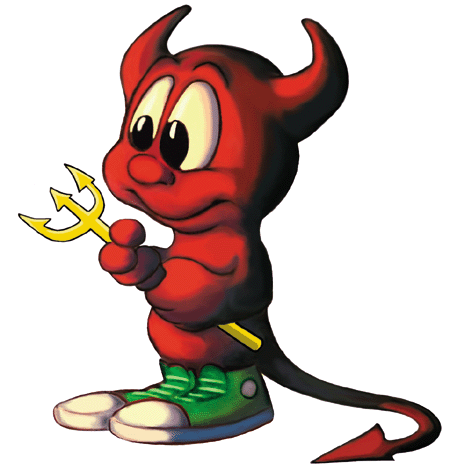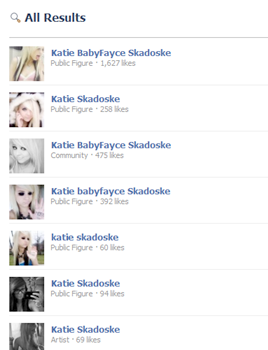When I was a kid, my grandmother had a favorite, cautionary phrase: “Idle hands are the Devil’s playground.” Just the mention of the devil was enough motivation to keep my little hands busy at all times.
 Back then, however, there were no video games or computers with which to occupy small hands. Don’t ask me what I did because I can’t remember…probably something archaic like reading a book.
Back then, however, there were no video games or computers with which to occupy small hands. Don’t ask me what I did because I can’t remember…probably something archaic like reading a book.
My dear granny’s words no longer carry the same weight as they did in 1971. Today, we have the World Wide Web, with its many dark corners, to keep ourselves busy; which leads me to the reason for this rant about the anonymity of the Internet. A few months ago, in the middle of a semi-conscious Facebook trawl, I happened to notice that several different accounts had the same profile picture, but different names, locations, employers, etc. So, with a click of the mouse, I began a journey into one of the most bizarre phenomenon that I have ever encountered. I have come to refer to it as the “Skadoske Syndrome,” a fond reference to a young girl named Katie Skadoske who, much like the Devil, has many other names…but I’ll run with this one, since it seems to be the most popular.
I have always been drawn to odd things (places, people, concepts); things that cannot always be explained in “rational” terms. Urban Legends, in particular, have always fascinated me. I have a respectable digital scrapbook of some of my favorites. I grew up in southern New Jersey, and that state’s “Devil” was a semi-obsession in my teen years (this included numerous trips to the isolated Pine Barrens in search of the remains of the Leeds’ Home, where the half-man/half-flying biped was born).
I suppose I can concede that it’s a bit unfair to draw parallels between Katie “Babyfayce” Skadoske and Mrs. Leeds’ thirteenth child, but the former is the epitome of Internet Urban Legend. She is, to me, the Keyser Söze of Facebook.
So, how did this tiny, blonde, cute, and very photogenic ingénue become such an enfant terrible? Apparently, when MySpace was the rage, Ms. Babyfayce posted (literally) hundreds of pictures of herself in various poses. I wonder if she realized she was about to set the photographic standard for all future social media networking sites (I hold her personally responsible for the barrage of “duck lips” pictures on Facebook).
Shortly thereafter, people began stealing the photos of Katie Babyfayce and most of them did one of the following: (1) pretended to be her, (2) created a fictional name and used her photos, or (3) created fan sites in her honor. Rumor has it that Babyfayce had to “retire” because of the stress of her “fame.” If anyone reading this knows how to go about retiring from a job that doesn’t pay, please let me know.
Her swift departure from the internet only served to fuel the somewhat perverse imaginings of her fans. Rather than fade into the abysmal archives of the web, she became a hot topic of discussion.
“What is her real name?”
“Where is she from?”
“Didn’t she die in a car accident in Hawaii?”
These are just a few of the questions I found on Yahoo! Answers, ChaCha, and several “fan sites.” The problem is; the user-submitted information only lead to more head-scratching and confusion. A simple Google search of the keywords “Katie Babyfayce” produced a staggering 99,400 results. At this point, in my mind, I heard Joe Pesci reciting one of my favorite quotes from JFK: “It’s a mystery wrapped in a riddle inside an enigma!”
I am admittedly (and shamelessly) OCD (albeit mildly) and I can’t stand loose ends. So, about 800 clicks later, I managed to find the following (and extremely unenlightening) semi/pseudo-facts:
Babyfayce’s real name may be Alexis Palmer, Katherine Skadoske, or Callindra Drogan. The last of the three was allegedly “a clever impersonator” and it was she who died in the car accident in Hawaii (which may or may not be a legitimate news story, since the website on which it was posted is questionably shady).
The legendary “Scene Queen” may live in one of the following places: Quezon City, Philippines, Bedfordview, Gauteng, South Africa, Los Angeles, CA, or New York, NY, depending on which random Facebook profile you choose.
Rumor has it that she attended “Pimp University” and is fluent in French, English, Latin, German, and Urdu. She is also an entrepreneur, holding several jobs at once, including Clair’s, Hollister Co., Still Don’t Want U To Know, and Pimp Daddy.
Recently, in an effort to stop the massive amounts of counterfeit Katies currently log-jamming Facebook, thousands of other members have devoted their young lives to “busting fakes.” They regularly search Facebook and other sites like Tumblr and Flickr for impersonators, and cloak themselves in mysterious monikers like “Stop Faker’s Of Katie Babyfayce” and “STOP “Katie Babyface Skadoske” FAKE!!”
The downside of OCD is information overload. During my “research,” I also discovered that Katie Babyfayce is not the only victim of cosmetic identity theft. I also found myself inundated with a gazillion photos of “Commonly Faked Girls” including Brookelle “Bones” McKenzie , Abby Tulo, Jenn “Curbstomp” Horner, Jenna Marie Mason, Taylor Parks, Dacey Lox, Dani Gore, and Izzy Murder, just to name a few. In other words, I was staring at a mountain of OCD triggers, but as I said, I have a mild affliction, so I tucked all of it away in a corner of my mind for later analysis. I knew there was a blog post hiding somewhere in there.

While the internet outwardly appears anonymous, there are those who know how to get around firewalls and security programs. The internet is a culmination of our society’s collective technical genius, and while it is an incredibly useful tool for gathering information in mere seconds, it is also used for harmful purposes. The only way to safeguard children is for adults to accept the seedy underbelly of the ‘net and be proactive.
I’ll leave you with the vision I had after just a few nights of slithering around Facebook: creepy, dark rooms, somewhere “out there,” in which sit innumerable devious characters, searching for something to do with their otherwise idle hands.


